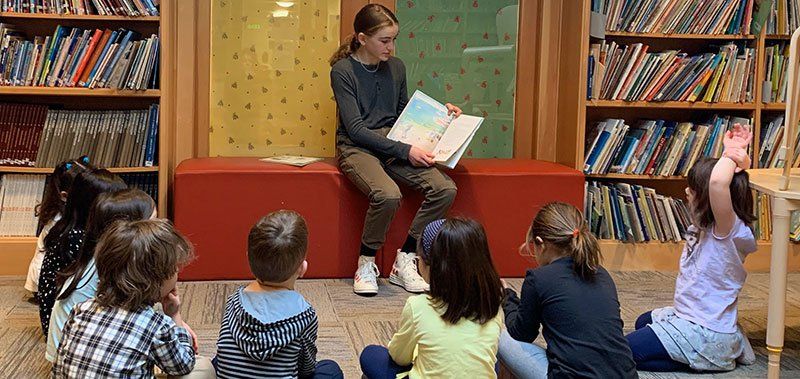Book List: Cultivating Resilience
Meagan Ledendecker • March 23, 2020

We love books, and we know your children do, too. That’s why each month we bring you a fresh list of ten titles that center on different themes. This month we’re thinking about resilience. Teaching our children to stick with it when a task seems challenging is a lesson that takes years to share. We encourage our children when they are faced with real-life difficulties. We can also share stories of people who have overcome their own struggles. If you’re interested, talk to your child about what resilience means, then discuss how the people in these biographies pushed through their own challenges to find success and happiness.
Henry’s Freedom Box: A True Story From the Underground Railroad
by Ellen Lavine, illustrated by Kadir Nelson
When we think of the underground railroad, our most common idea of what people went through involved traveling from house in the darkness of night. However, there were other ways people utilized to reach the freedom of the north. Henry sought the help of two trusted friends and mailed himself to freedom in a wooden box. Two notes of importance: this book is best for children in elementary grades and above, as it discusses complex racial issues for which younger children are not developmentally ready. There is one page on which the author describes Henry’s slave master as “good”. We assume the author meant good in a relative sense, but we think it would be advisable to stop on this page and have a discussion with your child about what the author could mean. Nevertheless, this book is an incredible tale and Henry’s story is an important one to pass on to younger generations.
Grace Hopper: Queen of Computer Code
by Laurie Wallmark, illustrated by Katy Wu
Grace was resilient from a young age, and continued to be so throughout her life. The book discusses her trouble putting together an alarm clock she took apart as a child, which led her to disassemble seven clocks in order to learn enough to fix the original one. Wallmark tells of her trouble passing Latin (which prevented her from entering college initially) and the work she did pass the course and reach her goals. In a male-dominated world, her peers focused on how to be a good wife and mother, while Grace studied math, sought out adventures, and spent more than a year convincing the Navy to allow her to join (even though she was considered too old and skinny by their standards). Hopper went on to be a pioneer of computer coding and her work is influential even today.
A Boy and a Jaguar by Alan Rabinowitz, illustrated by Catia Chien
This autobiography tells the incredibly moving tale of a young boy faced with stigma and driven by passion. Rabinowitz grew up as a stutterer, and was misunderstood at school. The only time he felt truly at ease was when he was with animals, and especially when he was able to visit a jaguar at the Bronx Zoo. Saddened by her bare enclosure, he promised her he would work to change that one day. As an adult, he beat the odds and became a scientist who fought for conservation, eventually helping to create the first and only jaguar preserve.
Shark Lady: The True Story of How Eugenie Clark Became the Ocean’s Most Fearless Scientist
by Jess Keating, illustrated by Marta Alvarez Miguens
As a young girl, Eugenie would stare at the sharks in the aquarium and marvel at the intelligence and beauty of the creatures most people thought were anything but. While her mother supported her dreams, most of society did not. She was encouraged to be a secretary or a housewife, but not an ocean explorer. As you might imagine, she worked hard to achieve her goals. During the course of her career, Clark discovered new species, debunked long-held assumptions about sharks, and became a strong advocate for conservation.
John Muir and Stickeen: An Alaskan Adventure
by Elizabeth Koehler-Pentacoff, illustrated by Karl Swanson
Muir is famous for his adventures, but this book zooms in on the events of one particular day. Accompanied by Stickeen, a friend’s dog, he set off to trek across an Alaskan glacier. Stickeen was no ordinary dog; he refused affection from humans and had a sense of adventure that rivaled that of Muir’s own. Faced with treacherous conditions and fading sunlight, the pair stuck together and found a way safely back to camp.
The Girl Who Ran: Bobbi Gibb, the First Woman to Run the Boston Marathon
by Frances Poletti and Kristina Yee, illustrated by Susanna Chapman
Bobbi loved to run, but as she grew older she found herself surrounded by people who told her she shouldn’t, including her own parents. She dreamed of running in the Boston marathon, so she set off from home to train across the country where no one could tell her not to. When she finally sent in her registration it was denied, so she put on a disguise, snuck into the race, and made history.
Lighter Than Air: Sophie Blanchard, the First Woman Pilot
by Matthew Clark Smith, illustrated by Matt Tavares
This lovely book tells the tale of Sophie Blanchard, a generally overlooked figure in history who happened to be the first female pilot. Other women had taken to the skies previously, but she holds the distinction of being the first woman to fly a balloon solo and steer its course. This is a great tale of overcoming boundaries and following childhood dreams.
The East-West House: Noguchi’s Childhood in Japan
by Christy Hale
Noguchi spent his boyhood feeling caught between two worlds. His American mother brought him to Japan as a young child so that they could live with his father. They soon realized his father had another family, and Noguchi and his mother went off on their own. Never quite feeling like he belonged in Japan, though also feeling out of place among Americans, he struggled to find his path. When he was eight years old he designed and oversaw the construction of his family’s new home, sparking a creative interest that would fuel the eventual career of this famous artist.
Nelson Mandela
by Kadir Nelson (The second book on our list illustrated by Nelson, he is also the author of this title.)
The book begins with Mandela’s boyhood, and how he was sent away from his home so that he might have a good education and more opportunities in life. Readers learn about how he became a lawyer and fought for justice among South Africans, eventually ending up imprisoned because of his work to fight apartheid. Though so much of this book focuses on Mandela’s struggles, it does so in a way that is accessible for children, and the story highlights the support he received from the people of his country, as well as his triumphant rise to lead South Africa later in his life.
Happy reading!

By Meagan Ledendecker
•
April 7, 2025
Did you know that the word "grammar" evolved from "glamour"? This linguistic connection reflects an ancient association between language and enchantment. When we introduce Montessori's sentence analysis work, we offer more than just a lesson—we present an enchanting gift! We regularly witness children falling in love with language as they uncover its patterns and structures. At the elementary level, children possess a reasoning mind, an active imagination, and a deep need for communication. The Montessori sentence analysis activities appeal to these characteristics, helping children connect as they creatively discover the underlying patterns of our language. Why Do We Teach Sentence Analysis in the Elementary? Children are natural pattern seekers. They love to identify and understand structures in the world around them, including language. We want them to fall in love with language. By engaging in hands-on grammar work, children develop an appreciation for the beauty of sentence construction. Sentence analysis provides clarity. Understanding sentence structure helps children write with greater precision and confidence. Analysis leads to synthesis. When children break down sentences, they gain the tools to build more complex and meaningful expression in their own writing. What Sentence Analysis Involves The elementary sentence analysis materials introduce a set of symbols (that correlate to what children have experienced with the Montessori grammar boxes and the symbols for parts of speech), along with color-coded arrows with questions on one side and grammatical names on the other. When breaking apart the parts of the sentence, children first identify what brings the sentence to life: the verb (predicate). To identify the subject of the sentence, children ask the questions from one of the arrows emanating out from the action: Who is it that? What is it? By answering those questions, the children are able to determine the subject. Let’s use a very simple sentence as an example: Josie jumped. The children first identify the action: jumped. They can underline this word in red and then can cut it out or tear it out in order to be able to place the word on the red predicate circle. Then they use the black arrows to answer the question: Who is it that jumped? Josie!
Contact Us
© 2024 The Montessori School of the Berkshires
PO Box 422, 21 Patterson Road, Lenox Dale, MA 01242
The Montessori School of the Berkshires (MSB) is a private independent coed school which inspires children to develop independent thinking, self-assurance, inner discipline, and a love of learning in an authentic Montessori environment nestled in the scenic Berkshire hills. We serve children in toddler, preschool, elementary, middle, and adolescent programs. MSB is an equal opportunity employer and provider. We do not discriminate on the basis of race, color, gender, religion, sexual orientation, disability, cultural beliefs, marital status, or ethnic origin in employment or the administration of admissions programs or policies.









